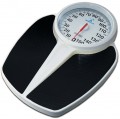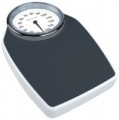Max. measurement weight
The largest weight that is allowed to be placed on the platform of this scale model. If this parameter is exceeded, the scales, at best, will not be able to show the correct data, at worst, they will completely fail. Obviously, the maximum weight is directly related to the purpose, but even kitchen scales can weigh both
up to 5 kg and up to 20 kg.
Actually, floor scales have the largest maximum measurement weight, in such models it can reach
200 kg or even more. And the most delicate are
jewelry models (refer to "Type"). Also note that in mechanical devices (refer to "Mechanism") the scale is usually graduated to the maximum weight.
Now on the market there are scales with such a maximum weight:
up to 1 kg,
up to 5 kg,
up to 10 kg,
up to 50 kg,
up to 150 kg,
up to 200 kg.
Scale division
Scale division value. Initially, the term "scale division" referred only to mechanical devices (see "Mechanism") and meant the distance between divisions on a scale; however, out of habit, they began to use it for electronic scales. Moreover, both there and there the meaning of this parameter is the same — in fact, it directly describes the accuracy of measurements. For example, if
the division value is 1 g, the weight on such devices can be measured with an accuracy of 1 g, regardless of whether it is a mechanical model or an electronic one.
Theoretically, the lower the division value, the more accurate the measurements and the more advanced the device is. On the other hand, high accuracy has a corresponding effect on the price, although in some situations it is not required in principle. So when choosing it is worth considering the features of the application of the device. For example, a kitchen scale with a division value of 0.5 – 1 g will be indispensable for a sophisticated cooker who cooks according to complex recipes with an abundance of ingredients in a small dosage; and for ordinary household cooking on a large scale, an accuracy of 10–20 g is quite enough. But there are also cases when, over the entire measurement range, the division value changes. So for more correct measurements (low weight), the accuracy can be measured in units of grams, for average values — in tens of grams, and already for heavyweights, where an er
...ror of 50 – 100 grams is not so critical, even in hundreds of grams. In such cases, we have a value for the general average range in the catalog (if we take into account the floor, then this is approximately for a person of 70 kg).Platform / bowl material
The material from which the working surface of the scales is made is
a platform or a bowl.
—
Plastic. An economical and highly functional material applicable to all scale types is plastic. Contrary to misconceptions, plastic can exhibit impressive durability; it's even employed for manufacturing floor scale platforms that accommodate 150 kg or more. Plastic scales offer practical advantages, such as not causing discomfort from coldness against the skin—this makes stepping onto such scales, including barefoot, a comfortable experience. This attribute is particularly valuable for
children's models(refer to "Type of scales"), adding to their overall appeal.
—
Metal. The metal is highly durable and gives the device a solid appearance. On the other hand, it costs more than plastic, and the mentioned advantages in the case of scales are rarely significant. Therefore, this material is used mainly in rather expensive scales. And in low-cost models, “metal” can mean a thin metal coating applied to a plastic platform.
—
Glass. The main feature of glass surfaces can be called a stylish appearance. Glass is not without reason considered fragile, however, to break it, you need a fairly strong blow. And the strength of modern glasses is enough even for floor scales with a weight limit of more
...than 100 kg. Another advantage of this material can be called ease of cleaning.
— Wood. Wooden platforms offer a distinctive and appealing appearance, characterized by unique colors and surface patterns. This choice is particularly favored by those who appreciate natural materials and the eco-friendly style. However, wood lacks significant practical advantages over materials like plastic, and it often comes at a higher cost. Consequently, wooden scales are primarily utilized for aesthetic considerations, resulting in relatively limited availability in the market.
— Rubber. Rubber is predominantly present in two categories of scales, namely pocket and floor scales (as mentioned earlier). In pocket models, the platform pertains to the lower part of the device that comes into contact with the hand during weighing. Rubber, known for its soft and comfortable properties, is a favored material for this type of application, making it highly popular in pocket scales. Similarly, in floor scales, rubber platforms are chosen for comparable reasons. Rubber's softer texture, reduced slipperiness, and enhanced comfort when standing make it preferable to hard plastic. Additionally, rubber platforms can incorporate massage protrusions (pimples), which could be uncomfortable on rigid plastic surfaces. Despite these advantages, the higher cost of rubber makes it less prevalent compared to other materials.
In addition to those described above, modern scales can also use other materials, sometimes quite unusual — for example, marble or stone (including in the form of a mosaic with which the platform is lined), or leather (leatherette). Most often, such materials are used for aesthetic reasons.
